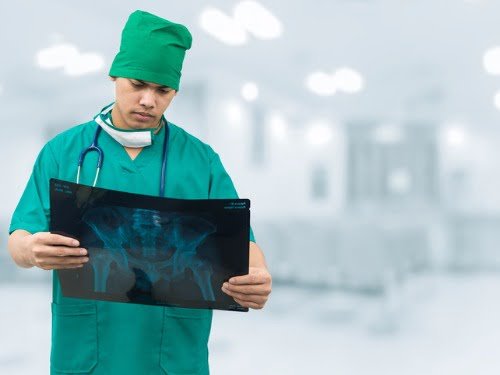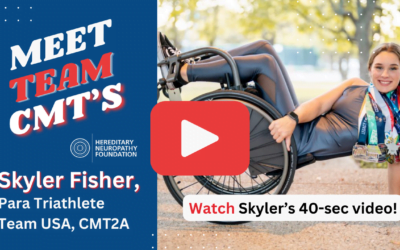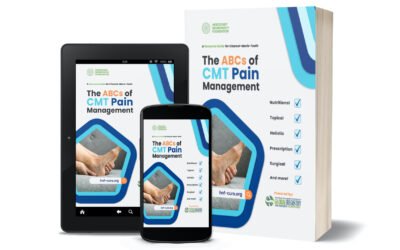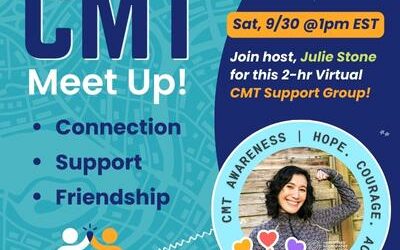Glenn Pfeffer, MD, is the Director of the Foot and Ankle Center at Cedars-Sinai Medical Center in Los Angeles.
Q: One of the most prevalent visible signs of CMT is foot drop. How does this occur and what, if anything, can be done to help those with this problem?
Motor weakness is the hallmark of CMT. The ankle dorsiflexors are frequently involved; these are the muscles that lift up the foot and ankle. When the Tibialis Anterior muscle weakens, the foot begins to drop down. This is usually a gradual process, occurring over months to years.
It is very important to keep the Achilles tendon in the calf stretched out. As the Tibialis Anterior muscle weakens and the foot drops down, a contracture of the Achilles will occur because the tendon is no longer being stretched out during gait. The worse the contracture, the harder it is for the weakened Tibialis Anterior to lift (dorsiflex) the ankle. Keeping the Achilles limber can keep a person walking normally for a long time. Stretch the tendon for 60 seconds 3 times each day. There are several stretching programs available, but the easiest and best is to place the front of the foot on a step and let the heel hang over the edge (hold on to the railing to keep your balance).
In more advanced cases, a brace may be required. There are several types available, which are generically called Ankle Foot Orthoses (AFOs). The brace should be lightweight and be flexible enough to allow the ankle to move up and down when walking. The Achilles pulls the ankle down and the brace brings it up. An Orthotist or certified Pedorthist are the professionals who fabricate such braces. The most common mistake I see is making these braces too heavy and rigid. A cushioned insert can be incorporated into the soul of the brace to help decrease stress on the foot and unload painful areas.
Q. Ankle stability is important for all people, but for those afflicted with CMT, it is vital in order to prevent frequent and often dangerous falls. What can you tell us about the nature of ankle stability and why people with CMT are so susceptible to falls? What can be done to strengthen the ankles (i.e. exercise, braces)?
There are three main problems that contribute to ankle sprains in people with CMT:
• The first is muscle weakness. The Peroneus Brevis muscle is the major dynamic stabilizer of the ankle and is often the first to be affected by CMT. In the early phases of CMT, it is important to keep the Brevis and the other lateral muscles as strong as possible. A few instructive lessons by a physical therapist in peroneal strengthening can be very helpful, especially early on. An elastic brace (such as used for an ankle sprain) may also be of benefit.
• The second is the varus, or an in-turned position of the heel. The center of gravity is simply not over the central axis of the heel, which increases the risk of a sprain. This occurs in conjunction with a very high arch (a symptom of CMT). An orthotic or heel insert with a 1/8 inch lateral heel wedge can help. A wide heel on the shoe is helpful to increase stability; and make sure not to let the outer heel get worn down.
• The third is a downward inclination on the inside of the foot, often referred to as a “plantar flexed” first ray. The bottom of the foot is not flat and the inside medial aspect of the sole hits the ground first, causing the foot to turn inward and the ankle to sprain. A custom orthotic (shoe insert) will often solve this problem by allowing the sole of the foot to lay flat in the shoe.
Try to do proprioception exercises from the outset of the diagnosis of CMT. Proprioception is the mechanism by which you know a position of your body without looking at it directly. You could call it balance. If you are able, stand on one foot for 30-60 seconds three times/day. Once you have mastered that, do it with your eyes closed. If you are in a brace or have advanced weakness or deformity, this exercise won’t be possible. In a person with mild to moderate CMT, this program will help increase strength and proprioception and decrease ankle instability and sprains.
Q. What are some of the other CMT-related problems regarding the feet?
Deformity of the toes occurs frequently in people who have CMT. An imbalance of muscle pull on the toes causes them to deform. The term “clawing” is used because each toe develops a fixed flexion contracture in the shape of a claw. The contracted toes don’t have enough room in shoes and put increased pressure on the ball of the foot, which becomes painful and callused.
While there is nothing one can do to prevent the muscle imbalance, the contractures can be avoided, or at least delayed. Twice a day, once in the morning and once before bedtime, stretch each of the toe joints. Flex down the joint at the base of each toe (Metatarsalphalangeal joint) as far as possible while bringing the middle joint (Proximal Interphalangeal joint) to a straight position. Hold for thirty seconds and then go onto the next toe.
Once a contracture develops, make sure to wear shoes that have a wide toe box to minimize pressure on the toes. A shoe repair shop can stretch out your normal shoes or special wide toe-box shoes can be purchased. Your shoes should have a cushioned sole and be made of a soft, stretchable upper material. A custom orthotic can help relieve pressure on the ball of the foot.
Q. What can you tell us about surgical procedures that could help CMT patients who suffer from foot problems?
 When conservative measures no longer work, surgery can restore function and significantly increase the quality of a person’s life. The goal is to obtain the most benefit with the least amount of surgery, while retaining the maximal amount of motion in the foot. Surgery is geared to correcting the common deformities discussed above. We have made great advances over the past decade. In the past, for example, a patient with CMT would undergo a triple arthrodesis, which is a fusion of the three major joints in the rear of the foot. Today, orthopedic surgery CMT specialists would realign the heel and the joints of the hindfoot without fusing them. Tendon transfers are performed earlier in the disease process to preserve a better balanced foot and to prevent injury.
When conservative measures no longer work, surgery can restore function and significantly increase the quality of a person’s life. The goal is to obtain the most benefit with the least amount of surgery, while retaining the maximal amount of motion in the foot. Surgery is geared to correcting the common deformities discussed above. We have made great advances over the past decade. In the past, for example, a patient with CMT would undergo a triple arthrodesis, which is a fusion of the three major joints in the rear of the foot. Today, orthopedic surgery CMT specialists would realign the heel and the joints of the hindfoot without fusing them. Tendon transfers are performed earlier in the disease process to preserve a better balanced foot and to prevent injury.
I will always remember my first CMT patient in 1989. She was 17 and could just get by wearing sneakers. She did not want to go out with friends, could not walk more than a few blocks, and had never let anyone other than her parents see her feet. After surgery, in her words, she “was able to wear cute shoes and went out on her first date.” Surgery for CMT, when necessary, can restore a quality of life that is worth the effort.














I have concerns. I recently went to a physisan to have plastic braces to replace my old ones. The last pair I had fit perfectly I switched suppliers and found one closer to home. The first mold had to be redone. When the second pair came in they did not fit the structure of my foot. Pictures were taken of my foot and the mold resent. I have concerns about falling because a mold was not made to correct the mistake yet they were sent back with pictures taken on my feet for the repair. I don’t believe they will fit properly Thank you kindly, Brenda Conner